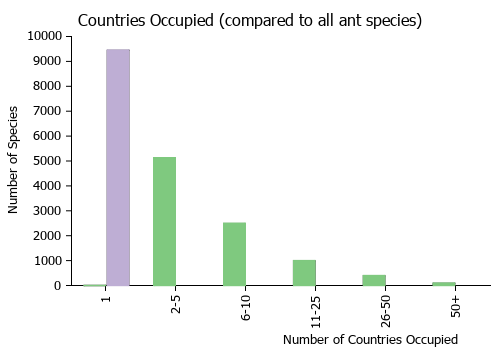Meranoplus deserticola
| Meranoplus deserticola | |
|---|---|

| |
| Scientific classification | |
| Kingdom: | Animalia |
| Phylum: | Arthropoda |
| Class: | Insecta |
| Order: | Hymenoptera |
| Family: | Formicidae |
| Subfamily: | Myrmicinae |
| Tribe: | Crematogastrini |
| Genus: | Meranoplus |
| Species: | M. deserticola |
| Binomial name | |
| Meranoplus deserticola Schödl, 2007 | |
Occuring in arid central Australia.
Identification
Schödl (2007) - Variability in this species becomes apparent in the rugosity of the shield. Occasionally the dorsal ocular margin may be confluent with the ventral scrobal margin. Specimens from South Australia are somewhat more shiny. Closest related to Meranoplus crassispina but different by the features given below under that taxon.
Keys including this Species
Distribution
Latitudinal Distribution Pattern
Latitudinal Range: -25.3° to -25.3°.
| North Temperate |
North Subtropical |
Tropical | South Subtropical |
South Temperate |
- Source: AntMaps
Distribution based on Regional Taxon Lists
Australasian Region: Australia (type locality).
Distribution based on AntMaps
Distribution based on AntWeb specimens
Check data from AntWeb
Countries Occupied
| Number of countries occupied by this species based on AntWiki Regional Taxon Lists. In general, fewer countries occupied indicates a narrower range, while more countries indicates a more widespread species. |

|
Estimated Abundance
| Relative abundance based on number of AntMaps records per species (this species within the purple bar). Fewer records (to the left) indicates a less abundant/encountered species while more records (to the right) indicates more abundant/encountered species. |

|
Biology
Castes
Worker

| |
| . | |
Nomenclature
The following information is derived from Barry Bolton's Online Catalogue of the Ants of the World.
- deserticola. Meranoplus deserticola Schödl, 2007: 392, figs. 22, 23, 63, 81 (w.) AUSTRALIA (Northern Territory, South Australia, Western Australia).
- Type-material: holotype worker, 14 paratype workers.
- Type-locality: holotype Australia: Northern Territory, Valley of Winds, The Olgas, 25.18°S, 130.44°E, 18.xi.1977, ANIC ants vial 42.37 (J.E. Feehan, T.A. Weir); paratypes: 7 workers with same data, 7 workers with same data but ANIC ants vial 44.232.
- Type-depositories: ANIC (holotype); ANIC, NHMW (paratypes).
- Distribution: Australia.
Unless otherwise noted the text for the remainder of this section is reported from the publication that includes the original description.
Description
Worker
Holotype. TL 6.85, HL 1.50, HW 1.73, FC 1.36, CS 1.61, SL 0.93, SI1 54, SI2 57, PML 1.25, PW 1.48, PMD 1.60, PMI2 108, ML 1.68, PTLL 0.44, PTLH 0.65, PTDW 0.55, PPLL 0.41, PPLH 0.73, PPI 57, PPDW 0.55, PT/PP 100.
Mandible with four teeth. Clypeus carinulate, in full face view bluntly bidentate, scarcely surpassing anterolateral frontal projections. Frontal carinae rather broadly and distinctly sinuately narrowed towards clypeus (FI 127). Head wider than long (CI 115), posterior preoccipital margin very shallowly concave only. Antennal scrobe surpassing middle of lateral sides of head, glossy with additional distinct transverse carinulae at rear, merging weakly defined into posterior section of head. Genae and ventrolateral sides of head carinate, preoccipital corners reticulate. Eyes relatively larger (EL 0.32, REL 0.21, with 19 ommatidia in the longest row), situated at about middle of lateral sides of head, dorsal ocular margin very close to ventral scrobal margin. Frons rather evenly longitudinally carinate, head only posteriorly reticulate. Promesonotal shield vaulted, with somewhat angulate profile, moderately wider than long (PMI 118), lateral sides narrowly translucently margined.
Pronotum anteriorly reticulate, remainder of shield longitudinally rugose, with few cross meshes. Propodeal declivity partly overhung by posterior mesonotal margin. Propodeal spines moderate long (PSL 0.50) situated above middle of length of declivity, straight, acute and moderately diverging when seen from above.
Petiole in lateral view triangular (PTI 67), with anterior face straight, meeting broadly convex posterior face in a crest. Postpetiole elongately nodiform with a rather large antero-basal tooth.
Gaster entirely microreticulate, with occasional glossy spots inbetween. Surface covered with evenly distributed pilosity consisting of short decumbent and long, more or less erect outstanding stiff hairs.
(n = 7). TL 6.10-6.90, HL 1.43-1.55, HW 1.65-1.80, FC 1.30-1.41, FI 125-129, CI 113-118, CS 1.54-1.68, SL 0.90-0.98, SI1 53-55, SI2 56-59, PML 1.20-1.30, PW 1.40-1.55, PMI 110-124, PMD 1.55-1.75, PMI2 108-113, ML 1.55-1.68, PSL 0.45-0.50, PTLL 0.43-0.48, PTLH 0.60-0.68, PTI 67-73, PTDW 0.53-0.61, PPLL 0.40-0.48, PPLH 0.68-0.75, PPI 57-63, PPDW 0.51-0.61, PT/PP 95-107, EL 0.29-0.34, REL 0.20-0.22, with 17-19 ommatidia in the longest row.
Type Material
Holotype worker, Northern Territory: '25.18S 130.44E NT. Valley of Winds The Olgas, 18 Nov. 1977 J.E. Feehan \ associated collector T.A. Weir \ ANIC ANTS VIAL 42.37' (Australian National Insect Collection). Paratypes. 7 workers, same data as holotype; 7 workers, same data as holotype but 'ANIC ANTS VIAL 44.232' (ANIC, Naturhistorisches Museum Wien, Vienna).
Etymology
The name refers to the preferred habitat.
References
- Heterick, B.E. 2021. A guide to the ants of Western Australia. Part I: Systematics. Records of the Western Australian Museum, Supplement 86, 1-245 (doi:10.18195/issn.0313-122x.86.2021.001-245).
- Heterick, B.E. 2022. A guide to the ants of Western Australia. Part II: Distribution and biology. Records of the Western Australian Museum, supplement 86: 247-510 (doi:10.18195/issn.0313-122x.86.2022.247-510).
- Schödl, S. 2007. Revision of Australian Meranoplus: the Meranoplus diversus group. Memoirs of the American Entomological Institute. 80:370-424.
